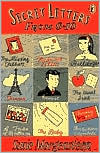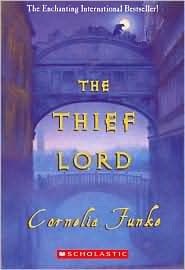 BIBLIOGRAPHY
BIBLIOGRAPHYMorgenstern, Susie. 1998. Secret Letters from 0 to 10. Trans. by Gill Rosner. NY: Viking. ISBN: 0670880078.
* 1999 Mildred L. Batchelder Award Honor Book *
* Winner of the French le Prix Totem Award, the equivalent of the U.S. Newbery Award *
PLOT SUMMARY
Ten-year-old Ernest Morlaisse has spent his entire life in a mundane schedule. Everyday he went to school, ate the same food, did his homework early, and spent the evening with his aged grandmother who lives in the past and hardly spoke to anyone. No television. No phone. No outings. He wears old-fashioned clothes that, besides his exceptional knowledge and his handsome looks, make him standout at school in the wrong way. Then one day, a vibrant new classmate named Victoria arrives and brings him into her family of two parents and thirteen brothers where there is food other than soup, chocolate, television, phones, and the world beyond his grandmother’s house. Now with life beginning to growing within himself, Ernest’s curiosity, about his father who had disappeared the day after he was born, continues to build until one day he writes and sends a letter to a man with the same name and receives hundreds in return.
CRITICAL ANALYSIS
Morgenstern’s Secret Letters from 0 to 10, originally published in France in 1996 and translated to English by Gill Rosner, is a refreshing story about young boy who’s structured life begins to bend and shift as his is introduced to the world outside his grandmother’s home, with the assistance of his new friend, and about what has happened to his father since he had disappeared Ernest was a day old. The plot is well constructed. It illustrates perfectly Ernest’s transformation from a sheltered life to one where he exposed to the world and to the story of what happened to his father. Each chapter is named after one of the characters within story that plays a significant part of in helping or effecting Ernest’s life.
The characters in the novel are wonderfully well developed and have their own individual personality that sets them apart. Ernest, who is a sweet, polite, kind, and smart boy; however, because his grandmother hardly speaks, even to him, as does Germaine, an old friend of Grandmother who cooks and also helped raise him. At the beginning of the novel, he follows the same routine day and day out with little thought. He does not speak unless he is spoken too and never asked a question. However, as the novel continues he changes to becoming curious, speaking and asking questions as he tries to uncover the secrets of his family and especially of his father.
Victoria de Montardent has a strong personality, which is almost a necessity for being the only girl in a family of thirteen brothers and parents who work for Foreign Affairs. From the moment she took a seat at Ernest’s desk at school she clasped onto him and preceded make him her friend (whether he liked it not), which in turn begins his transformation. Even though their personalities and how they live are quite different and almost complete opposites, Victoria soon appears as the perfect companion for Ernest as perfectly seen in her response to the notes left on her and Ernest’ desk by all the girls in their class that “love” Ernest and have told her to stay away, “I love Ernest. That’s all there is to it. And what’s more, I understand him, and I want him to be happy. We’re getting married in thirteen years, eight months, and three days. This is an invitation to our wedding” (Morgenstern, p. 35).
The story is set in France and has several cultural markers. The first and perhaps most noticeable marker is the names of the characters, especially their last names: Ernest Morlaisse, Victoria de Mortandent, Germaine, and Precious (Ernest’s grandmother). Another marker is the description of the neighborhood in which Ernest and Victoria lives. Down the street from Ernest’s house is a lovely neighborhood garden and street cafes, which is quite characteristic of France. Finally, the third marker that exudes the essence of a French culture is the presence of food, which a famous staple in the culture. Before Victoria befriended him, Ernest’s diet consisted toast and marmalade for breakfast and soup for lunch and dinner. However, thanks to Victoria, Ernest finally eats chocolate, chocolate-filled croissants, Couscous, and much more.
Though the details are faint and not entirely the focus of the plot, Secret Letters from 0 to 10 presents a refreshing story that exudes the essence of coming from another country and culture that both simpler and yet, like any well-written novel from of any other culture, the story is universal. Author Morgenstern, a native of New Jersey who has lived in France for more than thirty years, and translator Gill Rosner’s, also of France, collaboration has resulted in a wonderfully unique story in a subtle setting of another culture that is well-deserving of its honors and awards.
REVIEWS
BOOKLIST
Gr. 4^-7. Poor, 10-year-old Ernest Morlaisse: his mother died at his birth, his father deserted him one day later, and he is being brought up in a dreary, protected household by a grim, elderly grandmother, who rarely utters more than a few words and never smiles. Ernest's days are so structured they are completely devoid of joy and surprise, and the only mysteries life holds are the whereabouts of his father and the contents of a coded letter his grandfather sent just before he was killed in World War II. The arrival of Victoria de Montardent changes all that. Outgoing Victoria and her 13 vivacious brothers bulldoze Ernest into exploring life outside dull, familiar boundaries and help him experience the sensations and wonderment of love, loss, curiosity, pain, and joy. Morgenstern chronicles the awakening of Ernest's "sleepy old heart" through a wryly humorous narrative, presenting life's simple joys with such appreciation that events like going to the movies or answering the telephone seem as new to the reader as they do to a bemused Ernest. Quirky characters, heightening suspense, and hilarious situations are deftly combined in this tender novel, smoothly translated from the French, which examines a few of the large and small ways people affect one another. The richly rewarding happy ending will have kids begging for a sequel. Kathleen Squires.
SCHOOL LIBRARY JOURNAL
Grade 5-7-Winner of the French equivalent of the Newbery medal, this novel portrays the poignant journey of a young boy who learns to enjoy life, express his love for others and, at the same time, learn to love himself. Ten-year-old Ernest Morlaisse leads a quiet, uneventful life. He comes home from school, eats the same snack each day, and does his homework. He lives with his elderly grandmother who hardly speaks to him, especially about his dead mother and the father who deserted him when he was one day old. All this changes when a new girl, Victoria de Montardent, comes on the scene. For her, it's love at first sight. "We're getting married in thirteen years, eight months and three days" she tells him at one point. Her exuberance and joie de vivre captivate Ernest. Victoria and her 13 brothers befriend him, and he slowly begins to find joy in experiencing new things and encouraging his grandmother to leave her self-made prison behind. He also finds the courage to search for his father. The translation from the French is only noticeable because of a certain formality and precision in language that is not usually found in books for this age group. This formality lends considerable charm to the telling but requires a more thoughtful reader. Morgenstern has created extremely well-drawn, distinct, and sometimes quirky characters with eloquent dialogue. Since this is a quiet novel, it may need to be pushed. However, readers will not soon forget Victoria de Montardent and the journey Ernest takes to embrace life.
Jennifer Ralston, Harford County Public Library, Belcamp, MD
Copyright 1998 Reed Business Information, Inc
CONNECTIONS *Read more books by Susie Morgenstern: Book of Coupons, Sixth Grade, and Three Days Off.
*Have the readers discuss the importance of friendship and communication.
*Have the readers discuss the difference and similarities between someone their age in France to themselves in the United States.
*Have the readers discuss the importance of letters within story and outside the story.
*To further tie in the French culture, have the readers participate in French traditions such as having an event where the readers can try the many delicious food from France like Crepes and Ratatouille.

